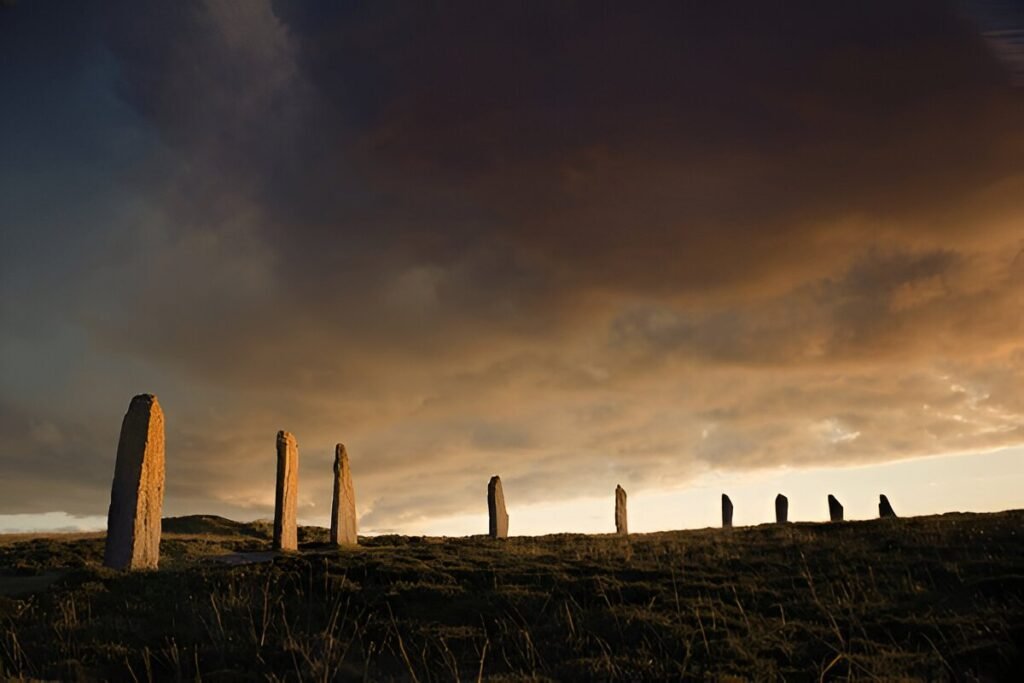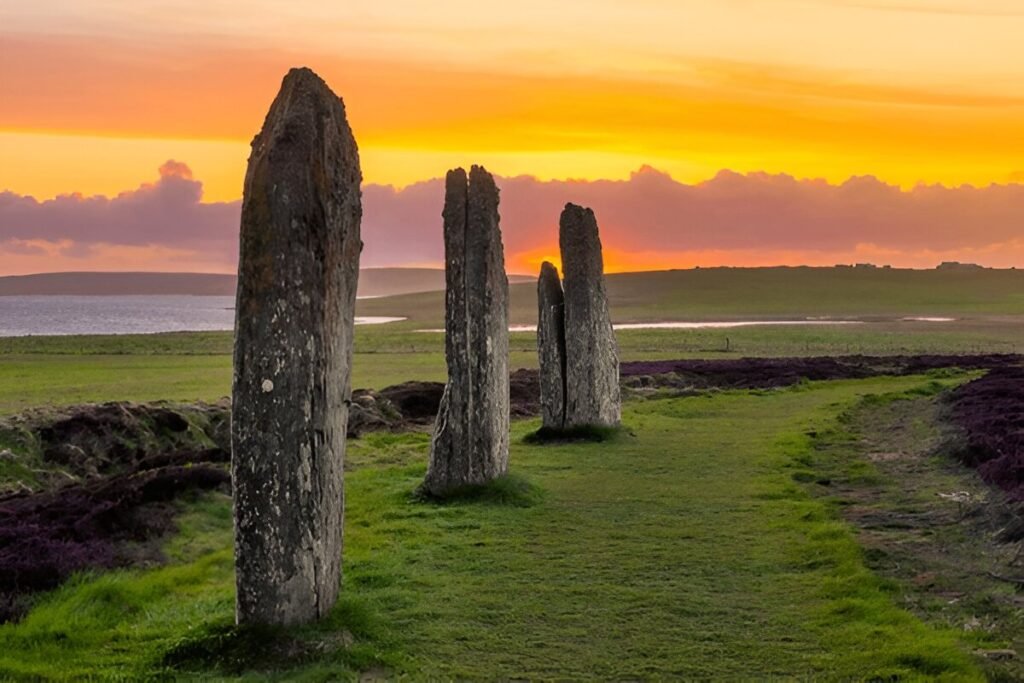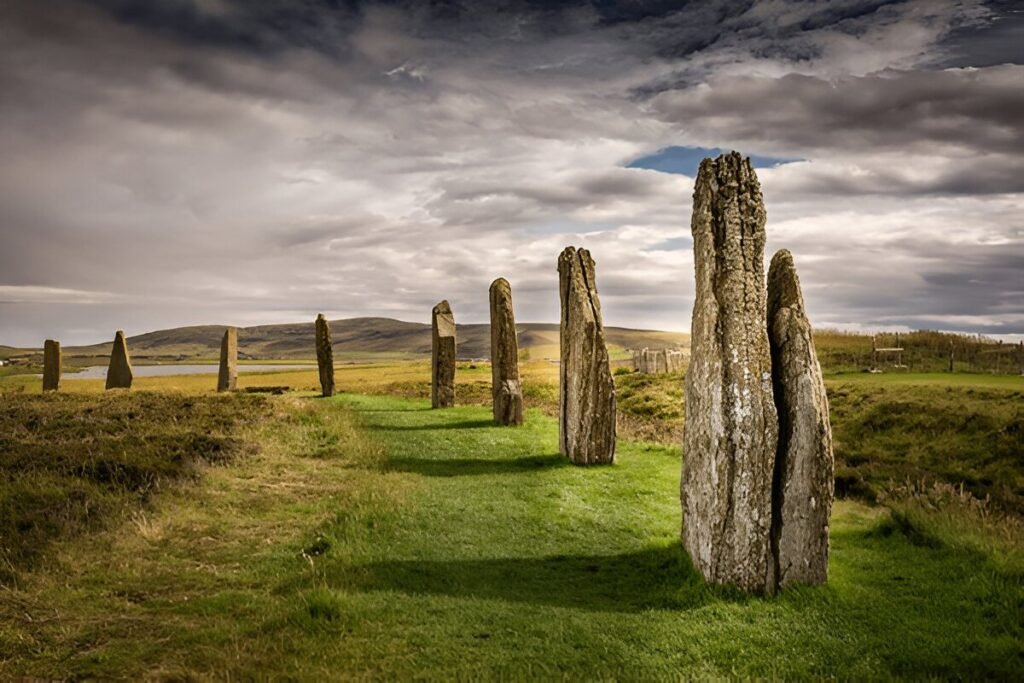Introduction
Scotland is a land steeped in rich history, and the Standing Stones of Orkney are among the most fascinating archaeological sites in the country. These ancient monuments are shrouded in mystery, evoking awe and wonder as they stand tall against the backdrop of the Orkney Islands’ rugged landscapes. Steeped in myth, legend, and centuries of history, the standing stones offer a glimpse into a time long past, when early civilizations left their mark on this remote part of Scotland.
In this blog, we will delve into the mystical allure of Orkney’s standing stones, exploring their origins, significance, and the best places to visit for an unforgettable experience.
A Journey Back in Time: The Standing Stones of Orkney

The Orkney Islands, located off the northern tip of Scotland, are home to some of the most impressive megalithic structures in Europe. These stone monuments were erected thousands of years ago, during the Neolithic and Bronze Ages, and they continue to captivate historians, archaeologists, and visitors alike.
Orkney is home to multiple stone circles and standing stones, but some sites are particularly famous for their grandeur and mystical aura. The Ring of Brodgar, the Standing Stones of Stenness, and the Maeshowe Chambered Cairn are just a few examples of the rich heritage found on this remote archipelago.
The Ring of Brodgar: A Circle of Mystery
One of the most iconic and largest stone circles in the British Isles is the Ring of Brodgar. Located on a narrow strip of land between Loch Stenness and Loch Harray, the Ring of Brodgar is a UNESCO World Heritage Site and one of the most famous Neolithic monuments in Scotland.
History and Significance
The Ring of Brodgar consists of 27 standing stones (originally 60), each towering up to 15 feet (4.5 meters) tall. Experts believe the site was erected around 2500 BC, making it over 4,500 years old. The purpose of the stone circle is still a subject of debate, but it is generally thought to have had religious or ceremonial significance. Some theories suggest it may have been a place of worship, while others speculate it could have been used for astronomical purposes, aligning with solstices or other celestial events.
The Experience
Visiting the Ring of Brodgar is like stepping into another world. The circle of stones is surrounded by breathtaking views of Orkney’s serene landscapes, with expansive skies and rugged terrain. The stones, weathered by centuries of wind and rain, stand in stark contrast to the softness of the surrounding greenery. The atmosphere is magical, especially at sunrise or sunset when the low light casts dramatic shadows across the stones.
The Standing Stones of Stenness: A Sacred Site

A short distance from the Ring of Brodgar lies the Standing Stones of Stenness, another ancient stone circle that is older and smaller than the Ring of Brodgar. This site is thought to date back to around 3000 BC, making it one of the oldest and most important ceremonial centers in the Orkney Islands.
History and Significance
The Standing Stones of Stenness originally consisted of 12 large stones, of which only four remain standing today. These stones are believed to have formed part of a Neolithic temple complex. Archaeological evidence suggests the site may have been used for ritualistic practices. The positioning of the stones seems to align with the sunrise at specific times of the year, further supporting the idea that the site had an astronomical function.
The Experience
The Standing Stones of Stenness are striking in their simplicity. Surrounded by rolling hills and the peaceful waters of Loch Stenness, the site feels serene yet imposing. The remaining stones, with their rough texture and imposing height, seem to carry the weight of history and the mystery of their ancient creators.
Maeshowe Chambered Cairn: Orkney’s Ancient Tomb
Another must-see site in Orkney is the Maeshowe Chambered Cairn, a prehistoric burial tomb that dates back to around 2800 BC. The cairn is a large, circular mound made of earth and stone, with a passage leading to a central chamber. Maeshowe is renowned for its remarkable preservation and the incredible solstice alignment that marks its significance.
History and Significance
The Maeshowe cairn is one of the best-preserved chambered cairns in Scotland and contains a fascinating series of Viking runes that were carved into its stones during the Viking Age. It is thought to have been used as a burial site, with the central chamber once holding the remains of important figures from the Neolithic period. The tomb is also aligned with the setting sun during the winter solstice, emphasizing its likely connection to solar and lunar worship.
The Experience
Entering Maeshowe feels like stepping into a time capsule. Visitors can explore the inner chamber, which is surprisingly large for a tomb, and imagine what it must have been like for those who constructed and used it thousands of years ago. The Viking runes add an intriguing layer of history, reminding visitors of the way cultures interacted with these ancient sites over millennia. The tomb’s alignment with the winter solstice also makes it a particularly fascinating place to visit during this time of year.
Other Notable Standing Stones on Orkney

Orkney boasts several other important sites for lovers of history and archaeology. Some of these lesser-known but equally captivating sites include:
1. The Stones of Kirbister
Located near Orphir, the Stones of Kirbister is a small stone circle with a mysterious atmosphere. While not as famous as Brodgar or Stenness, it offers visitors a peaceful experience away from the crowds.
2. The Barnhouse Settlement
This ancient village, located near the Ring of Brodgar, provides insight into the lives of Neolithic settlers. The Stone Age houses and standing stones are believed to have been used for both residential and ceremonial purposes.
Why You Should Visit the Standing Stones of Orkney
Orkney’s standing stones are more than just a series of rocks—they are a tangible connection to Scotland’s ancient past. Visiting these sites offers a rare opportunity to stand among structures that were built long before written history, giving visitors a deep sense of wonder and respect for the people who shaped these landscapes.
1. A Window into Scotland’s Prehistoric Past
Orkney’s standing stones offer a unique glimpse into a prehistoric civilization that valued both the natural world and the celestial forces. These monuments reveal the ingenuity and ritualistic significance of the Neolithic people who built them.
2. Scenic Beauty
Beyond their historical and cultural importance, the standing stones are set in some of the most stunning landscapes in Scotland. Whether you’re gazing across the Lochs, wandering through heather-clad hills, or standing in awe beneath the vast Orkney sky, these sites offer both natural beauty and historical significance.
3. A Connection to Myths and Legends
For many, visiting Orkney’s standing stones is about experiencing the mythical and mystical atmosphere that surrounds these ancient places. Whether it’s the idea of ancient gods or the secrets that lie beneath the stones, there is an undeniable sense of magic that surrounds these sites.
Conclusion
The Standing Stones of Orkney are a true testament to the rich history and enduring legacy of Scotland’s ancient past. These stone circles, burial cairns, and monuments stand as silent witnesses to a time when people lived in harmony with the land and the heavens. Whether you’re an archaeologist, history enthusiast, or simply someone who appreciates stunning landscapes, Orkney offers a chance to walk among some of the most awe-inspiring and enigmatic sites in the world.
For anyone seeking to uncover Scotland’s ancient secrets, the standing stones of Orkney provide an unforgettable journey into the heart of history and mystery.












